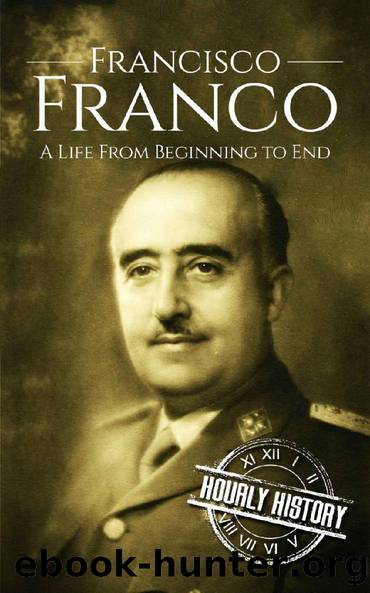Francisco Franco: A Life From Beginning to End by Hourly History

Author:Hourly History [History, Hourly]
Language: eng
Format: epub
Publisher: Hourly History
Published: 2017-09-26T00:00:00+00:00
Chapter Six
The Last Fascist Standing
âWe do not believe in government through the voting booth; the Spanish national will was never freely expressed through the ballot box. Spain has no foolish dreams.â
âFrancisco Franco
By the summer of 1943, Franco pretty much knew that it was game over for the Axis. After Mussoliniâs removal from power and brief imprisonment, Franco knew that he had to start considering other options. Word of the Italian dictatorâs removal came on July 25, 1943, and firmly launched Franco into damage control mode.
And once the tide had turned against the Axis powers, Franco immediately tried to distance Spain from its fascist connections, while still maneuvering to keep its anti-communist leanings intact. The struggle against the communists was of course the basis of the Civil War and the underpinnings of the Franco state.
But it was a war that had never entirely ended. Bolstered by the defeat of Francoâs fascist allies, at the end of World War II in the last few months of 1945, the partisans who had been hiding in the mountains and countryside of Spain were resurgent enough to ignite a guerrilla war against the regime. These fighters were known as the Spanish marquis since many of them had been holed up in remote French territory just north of the Spanish border at the close of the war. These so-called marquis, galvanized by the defeat of fascism, were now ready to come out of hiding and do their best to overthrow the Franco regime.
Franco wouldnât fully shake off this threat until 1951, when the communist fighters had become isolated enough to squeeze them out of the picture entirely. Meanwhile Spain found itself once again playing a strange game with the international community; on the one hand Spain was given the cold shoulder by the western democracies for its wartime connection to fascism, while on the other hand, manyâespecially in Britain and the United Statesâviewed Spain as a potential bulwark against communism, and wished to keep Franco propped up for this purpose.
In this fashion Francoâs Spain seemed to be placed in the same position in the post-war order as it had been during the war itself. The only new development on the international scene came in 1947 when Argentinaâs famed first lady, Maria Eva Duarte de Peron âor as she was better known âEvitaââcame for an official state visit. It was here that the woman that would become known for asking her country ânot to cry for herâ would cry out for Argentinaâs need to help Spain in any way it could.
Franco rolled out the red carpet for Evita, and the result was a stunning PR success, granting the Francisco public acclaim and a stronger appearance of legitimacy on the world stage than he had had in many years previous. Evita also came bearing the gift of economic subsidies in the form of a deal to deliver wheat on credit to the beleaguered Spanish state. And soon after Evitaâs visit, Franco would develop an even more powerful ally in the form of the United States.
Download
This site does not store any files on its server. We only index and link to content provided by other sites. Please contact the content providers to delete copyright contents if any and email us, we'll remove relevant links or contents immediately.
Blood and Oil by Bradley Hope(1549)
Wandering in Strange Lands by Morgan Jerkins(1389)
Ambition and Desire: The Dangerous Life of Josephine Bonaparte by Kate Williams(1366)
Daniel Holmes: A Memoir From Malta's Prison: From a cage, on a rock, in a puddle... by Daniel Holmes(1309)
Twelve Caesars by Mary Beard(1296)
It Was All a Lie by Stuart Stevens;(1286)
The First Conspiracy by Brad Meltzer & Josh Mensch(1158)
What Really Happened: The Death of Hitler by Robert J. Hutchinson(1144)
London in the Twentieth Century by Jerry White(1125)
Time of the Magicians by Wolfram Eilenberger(1112)
The Japanese by Christopher Harding(1108)
Twilight of the Gods by Ian W. Toll(1104)
Cleopatra by Alberto Angela(1081)
A Woman by Sibilla Aleramo(1073)
Lenin: A Biography by Robert Service(1063)
John (Penguin Monarchs) by Nicholas Vincent(1051)
Reading for Life by Philip Davis(1006)
The Devil You Know by Charles M. Blow(1005)
The Life of William Faulkner by Carl Rollyson(956)
